Sciatica is a painful condition that can have a serious impact on your quality of life. In rare cases, sciatica pain can become so bad you can’t walk, or significantly interrupt your work and other activities. But for most people, sciatica lasts less than six weeks, and can even clear up on its own without treatment [1].
Whether you have acute, chronic, or severe sciatica, it is possible to cure sciatica permanently. While recovery rates are excellent, studies differ in their sciatica cure rate conclusions: some say less than 50% of sciatica patients find a permanent cure, while others suggest it’s more than 75% [1].
The right course of action to effectively treat sciatica depends on the cause. Here, discover eight ways to cure sciatica permanently based on the underlying cause of your sciatica, as well as how to manage sciatica symptoms at home.
Table of Contents
- Symptoms and causes of sciatica
- How long does sciatica last?
- Can you cure sciatica permanently?
- Can sciatica get better on its own?
- 7 ways to cure sciatica permanently
- Managing sciatica symptoms without surgery
- Sleeping, sitting, and walking comfortably with sciatica
- How to cure sciatica permanently at home
Symptoms and causes of sciatica
Sciatica is characterised by shooting pains in the leg, hip, and lower back, which are normally localised to one side of the body. Lower back pain by itself doesn’t usually indicate sciatica.
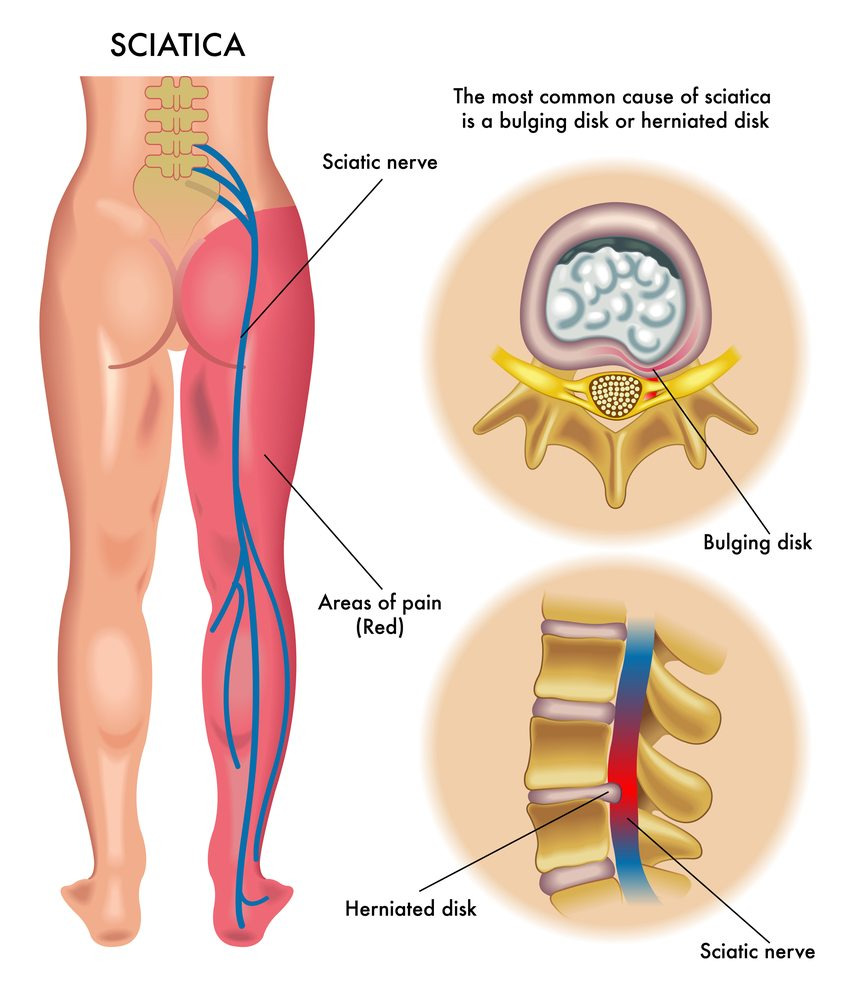
Sciatica happens when your sciatic nerve (which runs from your lower back to your feet) is compressed. This can happen as a result of:
- A bulging or herniated disc in the spine.
- Poor posture.
- Misalignment of the bones in your spine.
- Muscular spasm in the back, buttocks, or pelvis.
- Muscle weakness (this can also be a symptom of sciatica).
- Spinal stenosis (this is more likely to affect older patients).
- Spondylolisthesis (a slipped bone in the spine).
- Spinal abscess or tumour (in rare cases).
Studies have shown you may be more likely to have long-term sciatica if you have a physically demanding job or poor mental health [1].
You may be able to get limited support for sciatica and low back pain on the NHS. But with long waiting lists, persistent or severe symptoms can often benefit from private diagnostics and imaging tests. These can help you determine the cause of your sciatica, which will help you find the right cure.
How long does sciatica last?

In most cases, sciatica lasts no more than six weeks [1]. If your pain lasts longer than this, it’s a good idea to seek support from a back pain management specialist. They can help you discover why your sciatica hasn’t cleared up and find an appropriate treatment plan.
Book an appointment at Harley Street Specialist Hospital if you’re concerned about your sciatica symptoms.
Can you cure sciatica permanently?
Yes, it is possible to cure sciatica permanently. This is more likely for those with recently developed sciatica, but it can still happen even if you have long-term symptoms [1].
Some people never get another flare-up after one instance of sciatica, even if they don’t seek treatment. For others, sciatica treatment is an important part of recovery — whether it’s home exercises, steroid injections, or decompression surgery.
Can sciatica get better on its own?
Yes, sciatica can get better on its own. After a few days of rest, start moving again. Gentle regular movement is beneficial for sciatica, so try to keep walking and doing your daily activities if you can. A gentle yoga practice might also help with sciatica pain.
Take a look at these signs of sciatica improvement to see if your symptoms are on the right track.
7 ways to cure sciatica permanently
If your sciatica doesn’t resolve itself without treatment, here are seven ways to permanently cure sciatica.
1. Find out the root cause of sciatica

Finding out the cause of your sciatica is the first step in addressing your symptoms. This can help you find the right treatment and therefore recover more quickly.
At our pain clinic, we have an extensive diagnostic suite that can uncover where and why your sciatic nerve is trapped. You can then use the most appropriate method(s) below to permanently cure your sciatica.
2. Decompression surgery
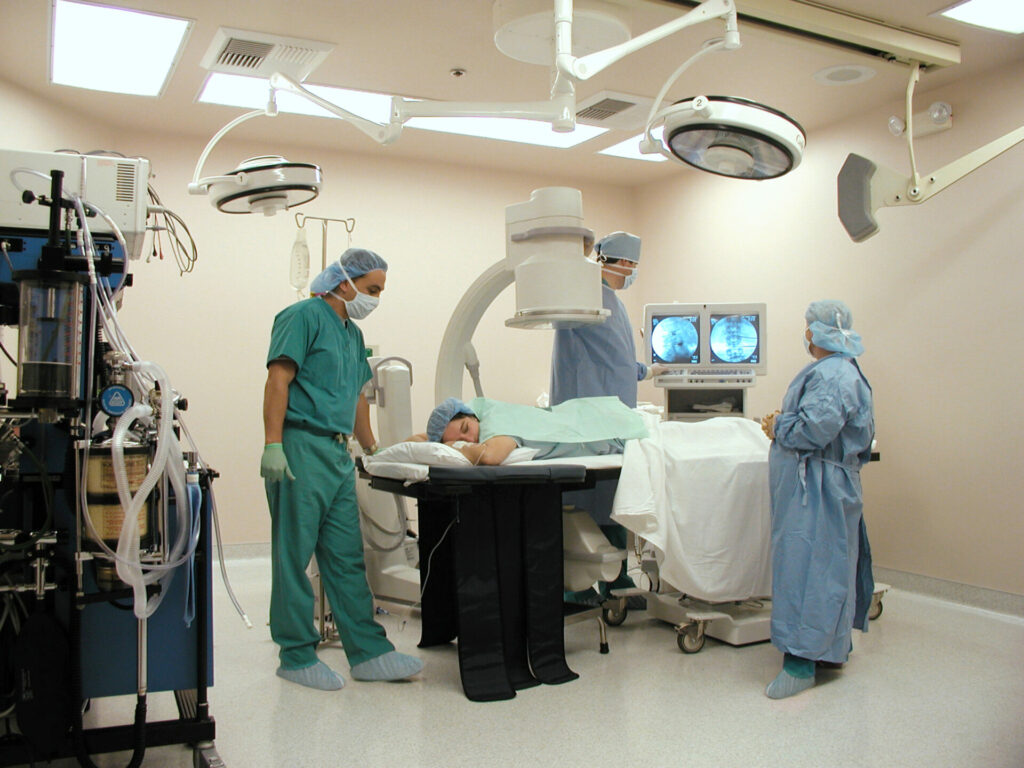
Best for: chronic conditions including slipped disc, spinal stenosis, spondylolisthesis
If conservative sciatica treatments like exercise and physiotherapy don’t work, you may be eligible for decompression surgery on your spine to treat sciatica. This involves an operation to remove a spinal bone or damaged disc section, relieving pressure on your trapped nerve. Parts of your spine may also be fused together to improve stability and posture.
Decompression surgery is usually only recommended if all other treatments have been unsuccessful.
Urgent surgery might be needed in cases of bilateral sciatica, where you experience sciatica symptoms on both sides of the body. That’s because this can indicate cauda equina syndrome, a more serious condition that needs urgent treatment.
3. Artificial disc replacement
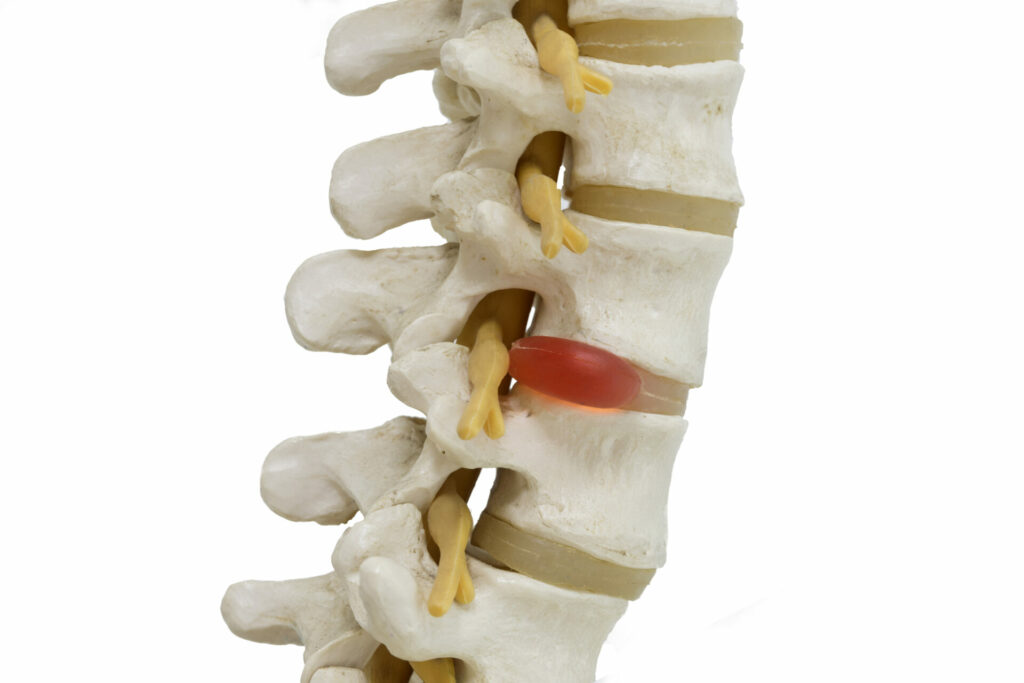
Best for: degenerative disc disease, arthritis
If the tissue between your vertebrae has become damaged or worn away, you may be able to have an operation to replace this with an artificial disc. Artificial disc replacement isn’t a first-line treatment, but it may be recommended if you have degenerative disc disease (in which the discs wear away over time) or arthritis (in which movement erodes the tissue).
Research shows that replacing a worn disc leads to fewer nerve compression complications (like sciatica) than spinal fusion surgery [3].
However, there are some risks to note, including failure, fracture, or loosening of the artificial disc. Your new disc can also become dislodged, which may need further treatment if it presses on your sciatic nerve.
4. Laminectomy
Best for: spinal stenosis
Laminectomy is a type of spinal decompression surgery that involves removing part of the bone that’s compressing the sciatic nerve. The lamina is the bony spur that sits on the roof of the spinal canal.
If your spinal canal becomes narrower due to spinal stenosis, removing part of the lamina can increase the space around your nerves, reducing the risk of compression or pinching.
5. Spinal fusion surgery
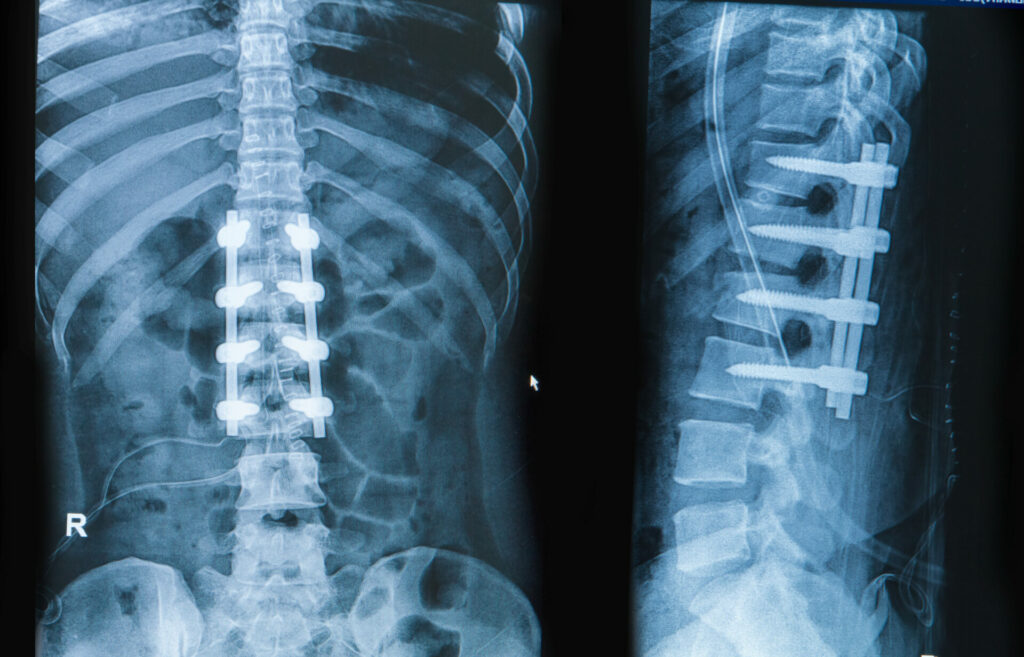
Best for: arthritis, degenerative disc disease, spinal stenosis, spondylolisthesis, fracture
Spinal fusion surgery is a procedure in which two or more of your vertebrae are fused together to create a stronger, more stable backbone. It’s usually used as a last resort, unless you have a spinal fracture that needs urgent surgical attention.
Spinal fusion might also be combined with other surgeries for sciatica. For example, if you have a problematic disc removed, the two surrounding bones may be fused to reduce friction and reduce pain in the long term.
6. Spinal abscess treatments

Best for: spinal abscess
A spinal abscess is a rare type of infection that affects 0.05% of those admitted to the hospital [4]. An abscess can compress the sciatic nerve, leading to symptoms of sciatica.
Abscesses are usually treated with antibiotics and surgery to drain the pus. One study found that of those with spinal abscesses, 73% of patients required abscess drainage as well as antibiotic treatment [4].
7. Spinal tumour treatments

Best for: spinal tumour
Like an abscess, a tumour or growth on the spine can put pressure on the sciatic nerve, leading to shooting pains in the legs and other sciatica symptoms. Tumours of the spine are very rare, and aren’t always a symptom of cancer.
However, it’s important to get a fast diagnosis if you suspect you may have a spinal tumour. You may need a biopsy (an operation to remove a tissue sample, which is then tested for malignancies). Your doctor can then prescribe treatments including radiotherapy, steroids, and surgery as needed.
Managing sciatica symptoms without surgery
While surgery is the only way to permanently fix a herniated disc, abscess, or tumour that’s causing sciatica, most people can alleviate their symptoms with non-invasive treatments. Here are four ways to manage and minimise sciatica pain without the need for surgery.
1. Stretching and gentle exercise

Best for: slipped discs, poor posture, muscle weakness, spinal stenosis
An effective exercise programme can help you get immediate relief from sciatica by reducing muscular tension, strengthening your back and core, and promoting circulation around the trapped nerve. This can alleviate sciatica pain and discomfort, giving you sciatica relief in a matter of minutes.
If you have spinal stenosis, try these sciatica exercises recommended by the NHS. You can also speak to a physiotherapist to get a tailored exercise programme for your symptoms.
2. Sciatica massage

Best for: muscular spasm, muscle weakness
If your sciatica is caused by muscular spasm (such as piriformis syndrome) or muscle weakness, try these massage techniques for sciatica pain relief. Massage can improve circulation, reduce tension, and ease pressure on your sciatic nerve [2].
3. Physiotherapy

Best for: slipped disc, poor posture, vertebral misalignment, spinal stenosis
Physiotherapy involves working with a trained physician to reduce stress on the sciatic nerve. They can manipulate your body and provide exercises to ease symptoms of a slipped disc, and help correct your posture if necessary.
There’s often a long wait for physiotherapy on the NHS. Booking an appointment with a private physiotherapist often means you’ll find a faster cure for your sciatica pain.
4. Steroid injections
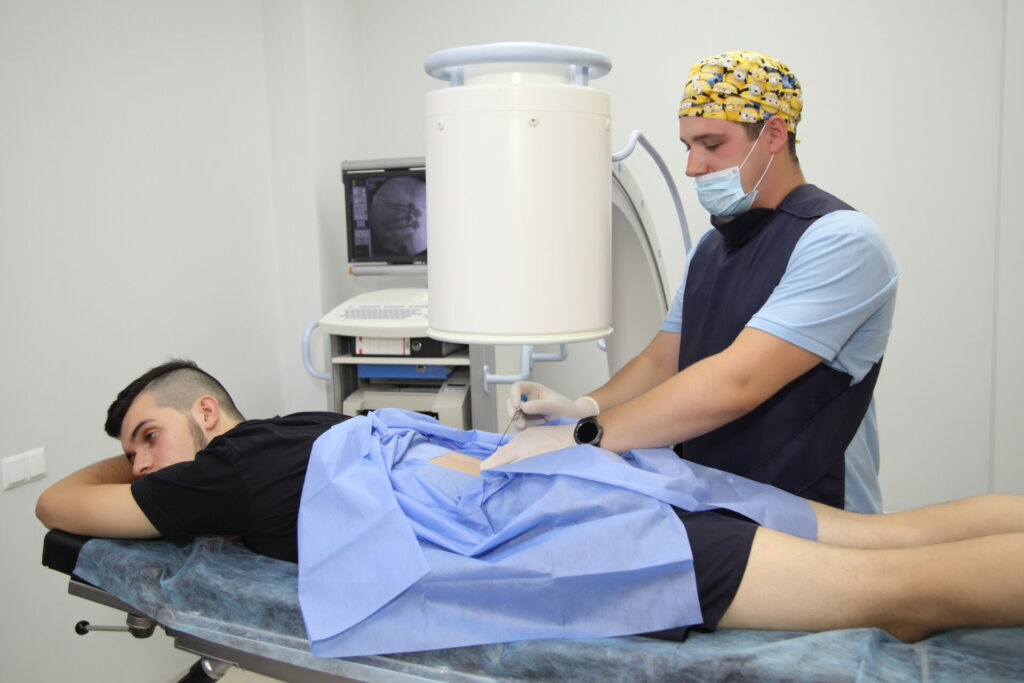
Best for: slipped disc, spinal stenosis, spondylolisthesis
Steroid injections are one of the most effective back and spine treatments. They alleviate sciatica pain by reducing inflammation around the trapped nerve. The steroid usually takes effect within a few days, allowing you to get back to your normal activities and strengthen your back and core muscles without pain.
Each injection offers several weeks to several months of pain relief. Find out more about how long epidural injections last for back pain.
Sleeping, sitting, and walking comfortably with sciatica

If sciatica is interfering with your day-to-day activities (including sleeping, sitting down, and walking), here are our top tips for alleviating sciatica pain.
Tips for sitting with sciatica
- Choose a chair with comfortable lumbar (lower back) support and adjustable height settings.
- Sit with your feet flat on the floor, and avoid crossing or elevating your legs.
- Make sure your neck, head, and lower back are supported by the chair.
- Stand up and move around frequently to stop your joints and muscles from stiffening up.
Tips for how to sleep with sciatica
- If you’re a side sleeper, sleep on the side that isn’t affected by hip and leg pain.
- If you’re a back sleeper, try switching to sleep on your side. This can alleviate pressure on your sciatic nerve, especially if it’s trapped by a herniated disc.
- Use pillows to prop yourself up in a comfortable sleeping position. Sleeping with a pillow between your knees can provide better back and hip support.
- Use a mattress topper to create a firmer sleep surface if it’s more comfortable. Softer mattresses don’t always offer enough support.
Tips for walking with sciatica
- Check your walking posture. Stand straight and tall, with your ears in line with your shoulders and your shoulders above your hips.
- Squeeze your core muscles as you walk to provide extra back support.
- Walk at a slower pace and take shorter strides to avoid putting too much pressure on your nerves.
- Wear walking shoes that offer plenty of arch and heel support, as well as cushioning for your sole.
How to cure sciatica permanently at home
If your sciatica doesn’t clear up by itself within a few weeks, you’ll need to commit to a sciatica treatment plan to give yourself the best chance of recovery. Many first-line treatments can be carried out at home, such as:
- Staying active if you can (in most cases, bed rest isn’t recommended for more than a couple of days).
- Specific exercises for sciatica, such as stretching and yoga poses.
- Cold or hot compresses to reduce inflammation.
- Non-steroidal anti-inflammatory drugs (NSAIDS) like ibuprofen, although there’s mixed evidence for these [1].
These tips should eliminate sciatica after a while. But if they don’t, it’s time to see a sciatica specialist. Book your appointment at our London sciatica clinic to get a diagnosis, assessment, and treatment — often on the same day.




